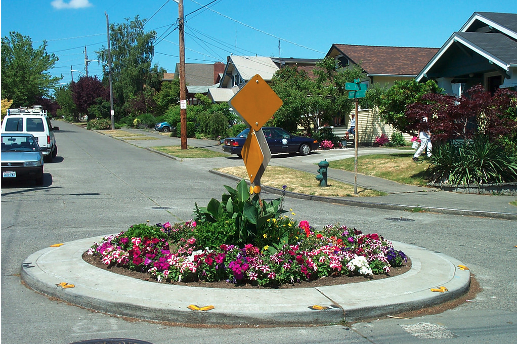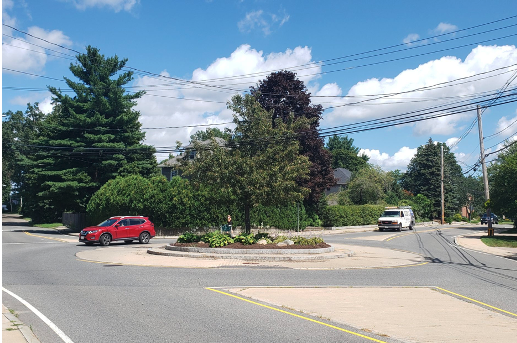Features
Raised circular islands constructed in the center of residential street intersections, mini roundabouts and neighborhood traffic circles can reduce speed by directing drivers to maneuver around them. Sometimes used instead of stop signs, they are unsignalized measures designed to support low speeds.
Mini roundabouts have traversable islands and yield control on all approaches, so they function like other roundabouts. Neighborhood traffic circles are typically built at the intersections of local streets to provide traffic calming or aesthetic benefits. They operate as two-way or all-way stop-controlled intersections, typically without raised channelization to guide approaching traffic into the circulatory roadway.
Example photos
Costs & considerations
| Feature | Estimated cost | Percent speed reduction |
|---|---|---|
| Landscaped traffic mini-circle | Asphalt street: $6,000 Concrete street: $8,000-$15,000 | 12-42% |
*Note: Estimates are based on past projects and commonly used materials, and may vary depending on roadway condition, location, time, and other factors. Estimates assume work can be accomplished within the roadway; costs will increase substantially if work requires ROW takings or curb displacement. The speed reduction percentages were sourced from FHWA's Engineering Speed Management Countermeasures Table linked in the resources below.
Potential speed benefits
Mini roundabouts and neighborhood traffic circles have been found to effectively reduce the speed most people drive on a road. In one analysis, mini traffic circles were found to reduce the 85th percentile speed by 11 percent on urban roads. (FHWA Speed Management Toolkit: Table 4)
Visit the FHWA table on potential speed reduction for more information. While this data is all collected under differing circumstances and in different environments (volume of vehicles, rural vs. urban areas, etc.), it is still a helpful gauge for what each countermeasure can do.
Learn more about mini roundabouts
When considering mini roundabouts and neighborhood traffic circles, it’s important to keep in mind the MassDOT Project Development Guidelines (Chapter 16). These are very specific design policies and standards you’ll need to adhere to, so that any changes you make meet federal and state guidelines
For example:
- Neighborhood traffic circle islands are usually 12-16 feet in diameter.
- The inscribed circles of mini-roundabouts are 45-90 feet with a design vehicle of an SU-30.
- Circulatory signage should direct through traffic to proceed to the right of the circle.
- The design vehicle for neighborhood traffic circles is a single truck with a 45-foot turning radius.
- Vegetation should be designed to capture stormwater, if possible. (NYC Street Design Manual)
Many of these details are included in Chapter 16 of our guide.
You can find more information about Mini-roundabouts and neighborhood traffic circles in these resources:
Additional Resources
-
Open PDF file, 571.19 KB, Portland, OR - Neighborhood traffic circles (English, PDF 571.19 KB)
-
Open PDF file, 1.18 MB, Somerville - Neighborhood traffic circles on Pearl Street (English, PDF 1.18 MB)
-
Open PDF file, 658.08 KB, Speed Management Cut Sheets - Neighborhood traffic circles (English, PDF 658.08 KB)

